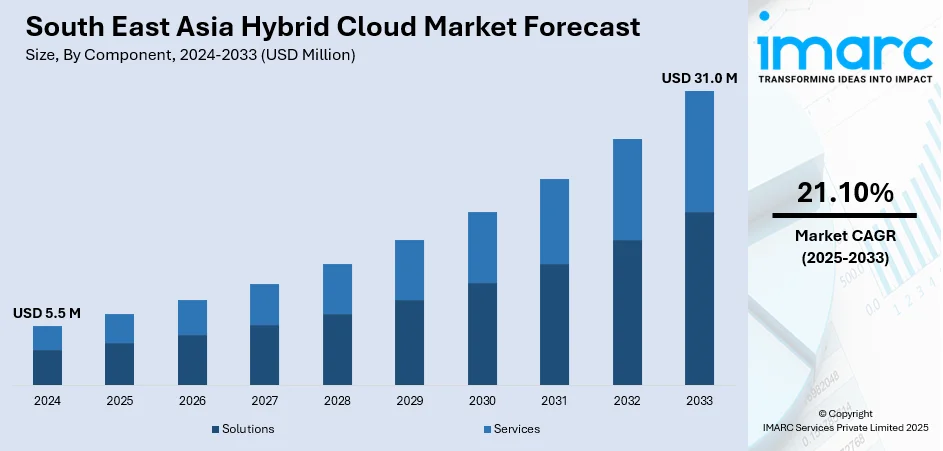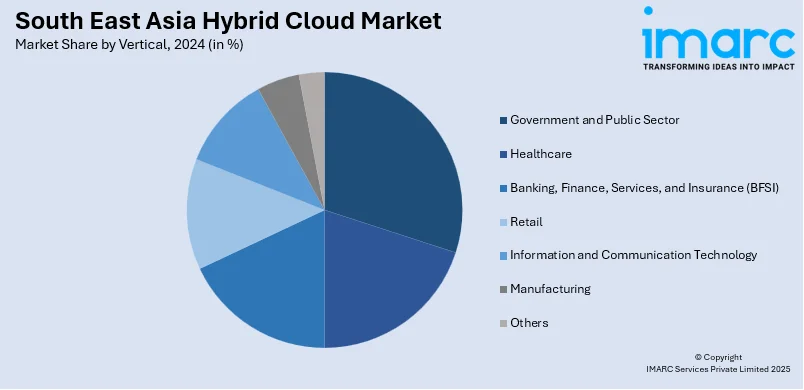
South East Asia Hybrid Cloud Market Report by Component (Solutions, Services), Organization Size (Small Enterprises, Medium Enterprises, Large Enterprises), Vertical (Government and Public Sector, Healthcare, Banking, Finance, Services, and Insurance (BFSI), Retail, Information and Communication Technology, Manufacturing, and Others), and Country 2025-2033
Market Overview:
The South East Asia hybrid cloud market size reached USD 5.5 Million in 2024. Looking forward, IMARC Group expects the market to reach USD 31.0 Million by 2033, exhibiting a growth rate (CAGR) of 21.10% during 2025-2033. The implementation of data security and compliance regulations, rapid growth in e-commerce and technology startups, and the adoption of cloud technologies through various initiatives and incentives represent some of the key factors driving the market.
|
Report Attribute
|
Key Statistics
|
|---|---|
|
Base Year
|
2024
|
|
Forecast Years
|
2025-2033
|
|
Historical Years
|
2019-2024
|
|
Market Size in 2024
|
USD 5.5 Million |
|
Market Forecast in 2033
|
USD 31.0 Million |
| Market Growth Rate 2025-2033 | 21.10% |
A hybrid cloud is a computing environment that combines elements of both private and public cloud solutions, allowing data and applications to be shared between them. It's essentially a hybrid or integrated approach to cloud computing, enabling organizations to enjoy the benefits of both private and public clouds while addressing specific business requirements and concerns. The private cloud is typically owned and operated by an individual organization. It is hosted within the organization's own data centers or on dedicated infrastructure provided by a cloud service provider. Private clouds offer greater control, security, and customization compared to public clouds. Whereas, public clouds are operated by third-party cloud service providers and offer computing resources (like virtual machines, storage, and services) to multiple organizations. These resources are hosted on shared infrastructure and are accessible over the internet. Public clouds are known for their scalability, cost-effectiveness, and flexibility. Consequently, hybrid clouds have become a popular choice for many enterprises seeking a balanced approach to cloud computing.

To get more information on this market, Request Sample
South East Asia Hybrid Cloud Market Trends:
Organizations in South East Asia are actively pursuing digital transformation strategies to remain competitive in the global market. Hybrid cloud solutions offer the flexibility and scalability needed to modernize IT infrastructures, enable innovation, and drive digital initiatives. In addition, data security and compliance regulations are becoming increasingly stringent in Southeast Asia. Hybrid cloud solutions allow organizations to keep sensitive data and critical workloads on-premises or in a private cloud while utilizing public cloud resources for less sensitive data, ensuring compliance with local and international regulations. Besides, Southeast Asian businesses often experience fluctuating workloads and seasonal demands. Hybrid cloud environments enable seamless scalability, allowing organizations to expand resources during peak periods and scale down during off-peak times, all while maintaining performance and cost control. Moreover, Southeast Asia has witnessed a rapid growth in e-commerce and technology startups. These businesses often rely on hybrid cloud solutions to efficiently manage their IT infrastructure, scale their operations, and deliver services to a large and diverse customer base. Furthermore, Southeast Asia has witnessed a rapid growth in e-commerce and technology startups. These businesses often rely on hybrid cloud solutions to efficiently manage their IT infrastructure, scale their operations, and deliver services to a large and diverse customer base. Additionally, government of Southeast Asia is promoting the adoption of cloud technologies through various initiatives and incentives. These efforts encourage organizations to explore hybrid cloud solutions as part of their IT modernization strategies.
South East Asia Hybrid Cloud Market Segmentation:
IMARC Group provides an analysis of the key trends in each segment of the market, along with forecasts at the regional and country levels for 2025-2033. Our report has categorized the market based on component, organization size, and vertical.
Component Insights:
- Solutions
- Services
- Professional Services
- Managed Services
The report has provided a detailed breakup and analysis of the market based on the component. This includes solutions and services (professional services and managed services).
Organization Size Insights:
- Small Enterprises
- Medium Enterprises
- Large Enterprises
A detailed breakup and analysis of the market based on the organization size have also been provided in the report. This includes small enterprises, medium enterprises, and large enterprises.
Vertical Insights:

- Government and Public Sector
- Healthcare
- Banking, Finance, Services, and Insurance (BFSI)
- Retail
- Information and Communication Technology
- Manufacturing
- Others
The report has provided a detailed breakup and analysis of the market based on the vertical. This includes government and public sector, healthcare, banking, finance, services, and insurance (BFSI), retail, information and communication technology, manufacturing, and others.
Country Insights:
- Indonesia
- Thailand
- Singapore
- Philippines
- Vietnam
- Malaysia
- Others
The report has also provided a comprehensive analysis of all the major regional markets, which include Indonesia, Thailand, Singapore, Philippines, Vietnam, Malaysia, and Others.
Competitive Landscape:
The market research report has also provided a comprehensive analysis of the competitive landscape in the market. Competitive analysis such as market structure, key player positioning, top winning strategies, competitive dashboard, and company evaluation quadrant has been covered in the report. Also, detailed profiles of all major companies have been provided.
South East Asia Hybrid Cloud Market Report Coverage:
| Report Features | Details |
|---|---|
| Base Year of the Analysis | 2024 |
| Historical Period | 2019-2024 |
| Forecast Period | 2025-2033 |
| Units | Million USD |
| Scope of the Report | Exploration of Historical and Forecast Trends, Industry Catalysts and Challenges, Segment-Wise Historical and Predictive Market Assessment:
|
| Components Covered |
|
| Organization Sizes Covered | Small Enterprises, Medium Enterprises, Large Enterprises |
| Verticals Covered | Government and Public Sector, Healthcare, Banking, Finance, Services, and Insurance (BFSI), Retail, Information and Communication Technology, Manufacturing, Others |
| Countries Covered | Indonesia, Thailand, Singapore, Philippines, Vietnam, Malaysia, Others |
| Customization Scope | 10% Free Customization |
| Post-Sale Analyst Support | 10-12 Weeks |
| Delivery Format | PDF and Excel through Email (We can also provide the editable version of the report in PPT/Word format on special request) |
Key Questions Answered in This Report:
- How has the South East Asia hybrid cloud market performed so far and how will it perform in the coming years?
- What is the breakup of the South East Asia hybrid cloud market on the basis of component?
- What is the breakup of the South East Asia hybrid cloud market on the basis of organization size?
- What is the breakup of the South East Asia hybrid cloud market on the basis of vertical?
- What are the various stages in the value chain of the South East Asia hybrid cloud market?
- What are the key driving factors and challenges in the South East Asia hybrid cloud?
- What is the structure of the South East Asia hybrid cloud market and who are the key players?
- What is the degree of competition in the South East Asia hybrid cloud market?
Key Benefits for Stakeholders:
- IMARC’s industry report offers a comprehensive quantitative analysis of various market segments, historical and current market trends, market forecasts, and dynamics of the South East Asia hybrid cloud market from 2019-2033.
- This research report provides the latest information on the market drivers, challenges, and opportunities in the South East Asia hybrid cloud market.
- Porter's five forces analysis assist stakeholders in assessing the impact of new entrants, competitive rivalry, supplier power, buyer power, and the threat of substitution. It helps stakeholders to analyze the level of competition within the South East Asia hybrid cloud industry and its attractiveness.
- Competitive landscape allows stakeholders to understand their competitive environment and provides an insight into the current positions of key players in the market.
Need more help?
- Speak to our experienced analysts for insights on the current market scenarios.
- Include additional segments and countries to customize the report as per your requirement.
- Gain an unparalleled competitive advantage in your domain by understanding how to utilize the report and positively impacting your operations and revenue.
- For further assistance, please connect with our analysts.
 Request Customization
Request Customization
 Speak to an Analyst
Speak to an Analyst
 Request Brochure
Request Brochure
 Inquire Before Buying
Inquire Before Buying




.webp)




.webp)












